|
|
I recently acquired a new set of chisels and gouges and I needed to make a home for them.

This tool rack is a fairly simple composition. It will hold 40 chisels, so I have a little bit of room to grow.

I can see all the blades and I can remove the blade easily. A pair of hooks will hold the rack on a wall or in a case.
Or the rack can stand on it’s own. The rack can even be laid flat if it is on an unstable surface, and the tools can still be accessed easily.
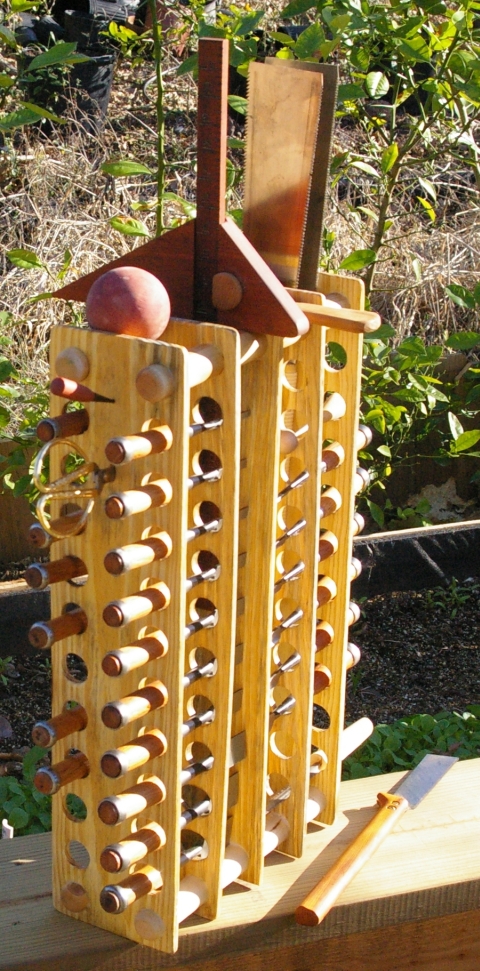
There is a lot of room between each of the tools, so they can be grabbed easily.
With the tools shown here and a few planes thrown in, I am ready to go to work.
As an extra note, the ball is a very important tool. I use it as a mallet, when tapping my chisels into wood.
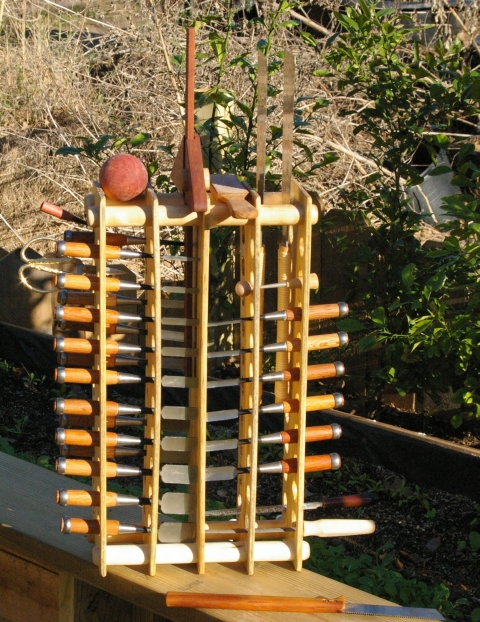
Bob
Part 1, Part 2, (Part 3,) Part 4, Part 4.5, Part 5
I finally finished the remaking of the chisels and gouges.
I am very pleased with the look and feel of the handles.
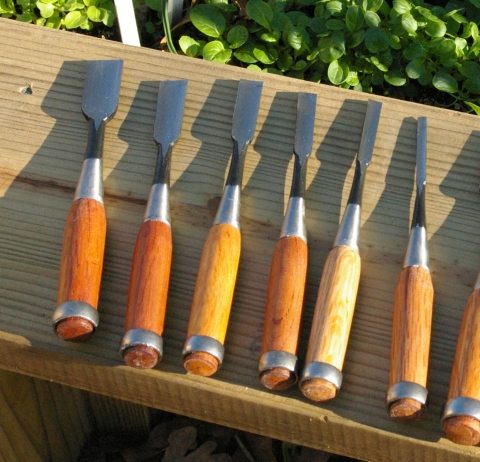
Click on the image above for a bigger picture.
Here is the full set.

After shaping all the handles and setting the hoops, instead of soaking the ends in water to expand the wood and hold the hoops, I boiled them in my wax mix. This gave the wood such a wonderful feel and look, that I think I will do all handles this way from now on. I love the effect. I suspect they will hold up better too!
I did encounter one fairly important issue during the process. While setting the hoop on the smallest of the chisels, the chisel cracked.
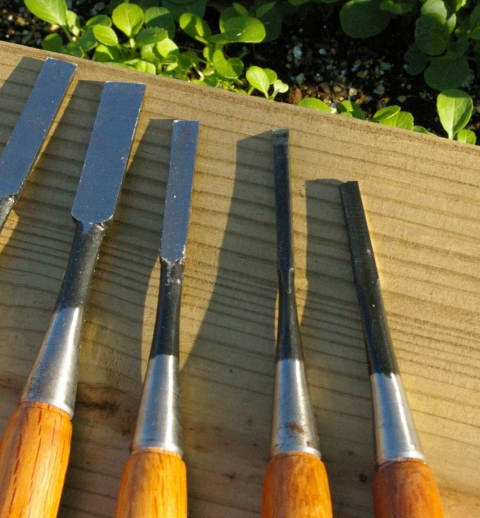
The chisel on the far right is the smallest one. It is made sort of like a sash chisel with a deeper cross section to strengthen it, since it is a fairly narrow tool.
I use and make a lot of fairly small tools. This tool did not meet my standards for tool strength. I don’t think the force that I applied was more than any tool with a hoop should be expected to receive.
**As an update, so as not to prejudice you against some great tools, in Part 4, Grizzly support saved the day.***

On the whole, I am quite pleased with these chisels. Since I was glad to reshape them and set the hoops, The end result is a very nice and quite functional set of chisels.

The real treasures here are the gouges. They are well shaped, work wonderfully and keep their edge well.

I have tested them on osage orange, oak and mesquite, and they do quite well on all of these woods. So I have no complaints at all with the gouge set.
I plan to grind the small chisel that broke down to an edge and use it shorter. With this experience, I will be a bit nervous using the smallest of this chisel set. While smaller tools are always going to be easier to break than larger tools, if you are afraid to use a tool, it is not going to be as useful.
Bob
Part 1, Part 2, (Part 3,) Part 4, Part 4.5, Part 5
Part 1, (Part 2,) Part 3, Part 4, Part 4.5, Part 5

Pulling off the rings, you can see the gummy glue remains on the bases of the tools.

One part of this process is going to be giving myself a better stub to put the ring on.

After removing a few rings,
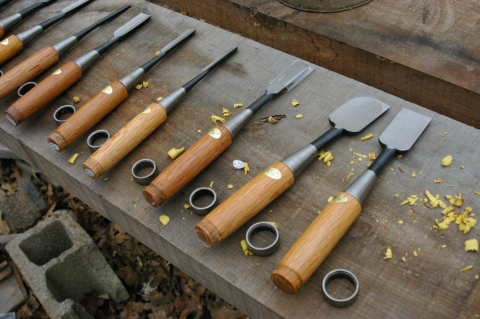
I find that some of the rings are a bit large and some are amazingly tight. So I am going to have to do a bit of rigging to get these rings on perfect. For a smaller hand, or someone who prefers a shorter handle, this would be fine, but I like a long handle. I think it gives me more control, despite a lot of other folk that feel a short handle give them more control. As it is, I may have to remake a few of the handles or rings to have these suit my tastes. So once again the ergonomics issue rears it’s head with these tools. Fabulous, tools so far, and I am tempted to leave off the rings and round the handle to fit in the palm. This would solve everything, and they seem to work quite well as push tools.
The heating of the rings was taking too long, sixteen tools is a lot to process. So I doubled up.

The next part is to deal with the tool shape. I went straight to work on that. I have made so many different styles of handles, that I have a good feel for what works well for me.



Nothing too complex, but with the rounding of the edges and having the front blend into the same angle as the blade, the indention between the metal and the wood gives me a good feel of registration when I hold it, and it is relaxed and comfortable instead of the rough and inflexible feel of the original shape.
Now I really like the feel of it all. I may reduce the length just a bit and put the ring on, so I can pound it and still have it fit to the palm. I suspect that the average Japanese woodworker would take a half inch off of these as a matter of course, so that would be no problem. The glue might upset them a bit, but I suspect these were made specifically for the American market.
More later on this process as I get further along on the task.
Bob
Part 1, (Part 2,) Part 3, Part 4, Part 4.5, Part 5
(Part 1), Part 2, Part 3, Part 4, Part 4.5, Part 5
I got tempted and made the purchase of the full set of Grizzly Japanese Chisels and the full set of Grizzly Japanese Gouges. The reviews did not like the finish and feel of these chisels and gouges, but I was quite willing to adjust that. Japanese chisels are typically made with the expectation that the user is going to modify the handle to suit them. The reviews indicated that they held an edge and were a good value, so I saved up for a few months and made the order.
My first impression was quite positive. Nice having a good range of chisels and gouges. The hoops however are way too far out to use, and the grip, simple as it is, is not quite right. So the first thing to do was to remove the hoops.
I tried the methods that worked for me before, without any luck.
So I decided to improve my hoop punch.

I used the new gouges to make the Punch.

The gouges worked amazingly well on the osage orange I used for the punch. This was before sharpening or flattening. I checked, the chisels will shave hairs of your arm. Not in a clean one pass shave, but it will remove hairs from your arm, so these tools came ready to use, osage is a bear to work, so these do pass muster for holding and edge and retaining it. The blade itself took clean well controlled chips out. I love it!
The hoops still refused to budge. They chipped out the osage before moving. Anyone who knows osage will know how extraordinary that is. After close analysis and examination, it looked like they were glued and wedged on.
Here was the cure, forgive the filthiness of the hot plate, it has served me as a solvent, die, pigment, wax and other odd formula heating station for years and that grunge will take the enamel with it when it goes.
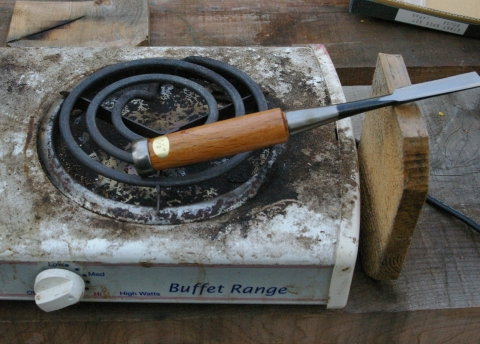
With care and attention, no burning of wood was needed to remove the hoops. A nice hot ring and some hammering took the hoops off.

So as far as the tools go, I have to agree with other reviews, the tool itself is great, even ready to go from the start. However the ergonomics of the handle and dealing with the hoops is a bit messed up. I will follow up with this project as I work it out.
Bob
(Part 1), Part 2, Part 3, Part 4, Part 4.5, Part 5
I recently started a thread on Woodnet, Woodworking Handtools, Asking, “What project got you started?”
The resulting posts were amazing. It was pretty obvious that the majority had gone as far as they could with conventional powered tools and they had to move to hand tools to achieve the results they desired.
A few folk however were drawn to the hand tool first. So the draw of the tool was first in their minds.
I plan to go to the Lie-Nielsen Toolworks Hand Tool Event in Austin this Friday. I expect to learn quite a bit. As a self taught/taught by reading and the net hand tool user, I suspect that I may have missed a few key points along the line. By watching in person, I expect to be able to see a bit more of the use that has been passed on by tradition.
Tradition, mentor teaching, that is the old path. Now days it is a much rarer path. For good or ill it is now the minority. Maybe they can teach me to use a Western saw well. Don’t count on it. 😉
Bob
|
|





















 A page Dedicated to My Writing
A page Dedicated to My Writing
Recent Comments